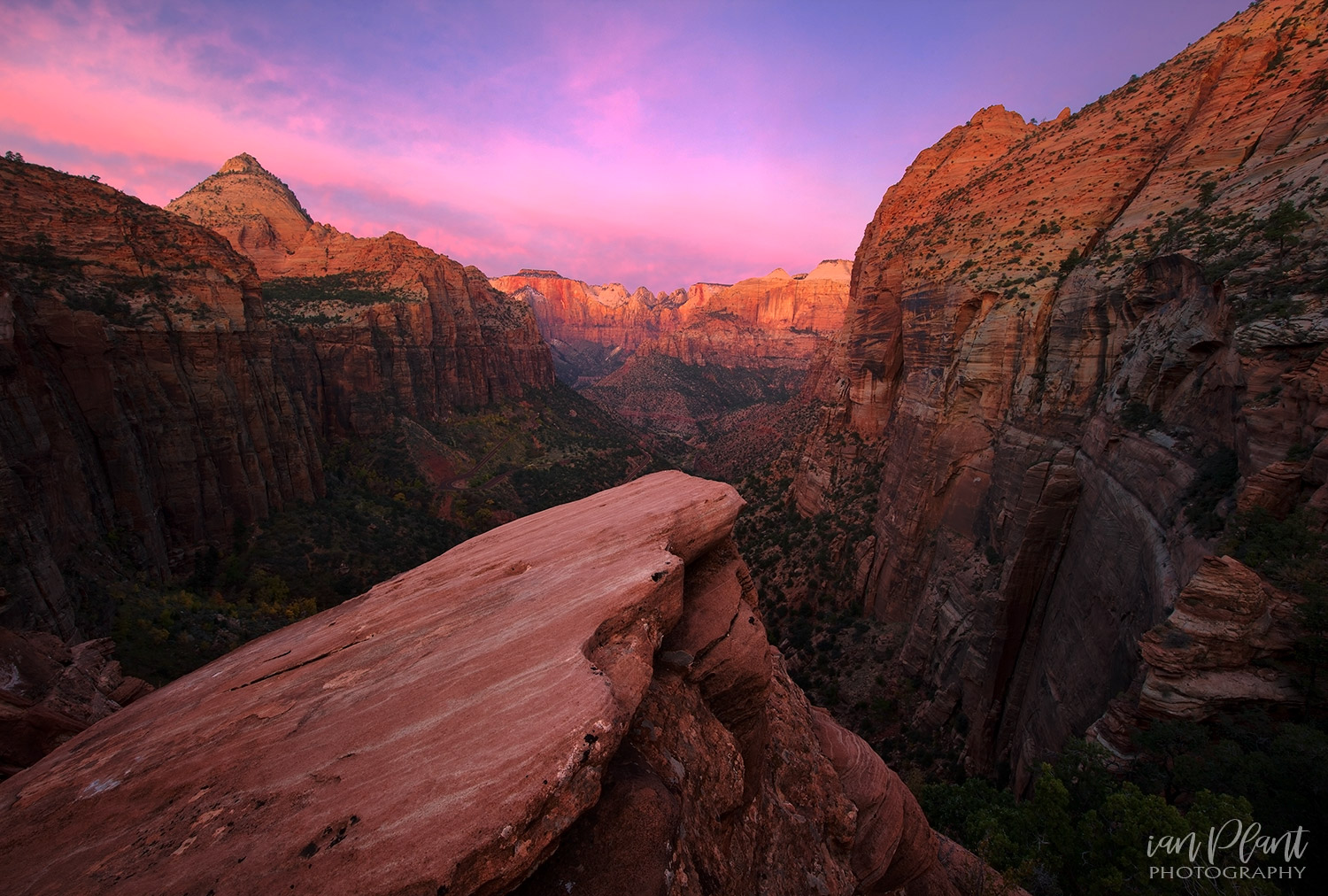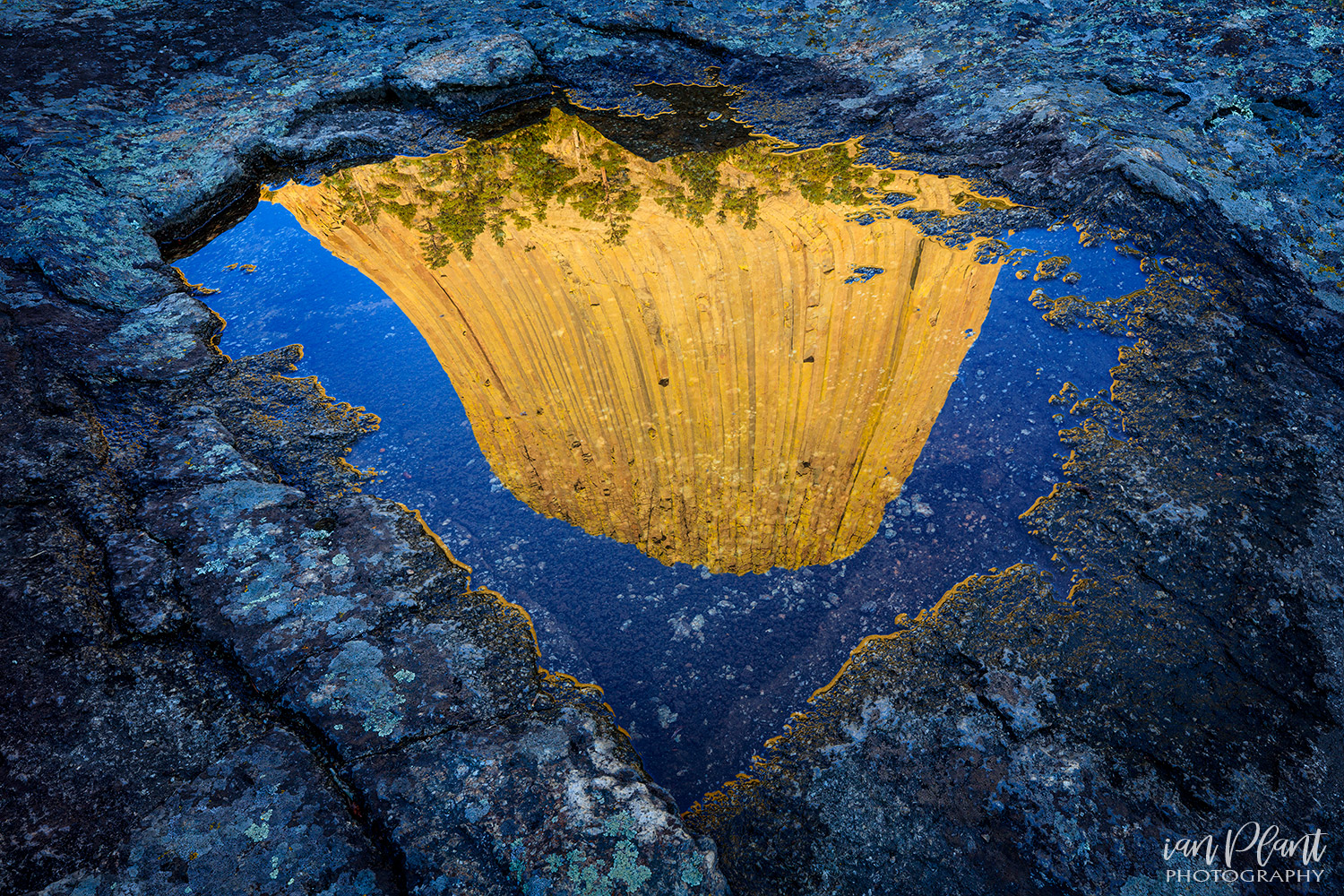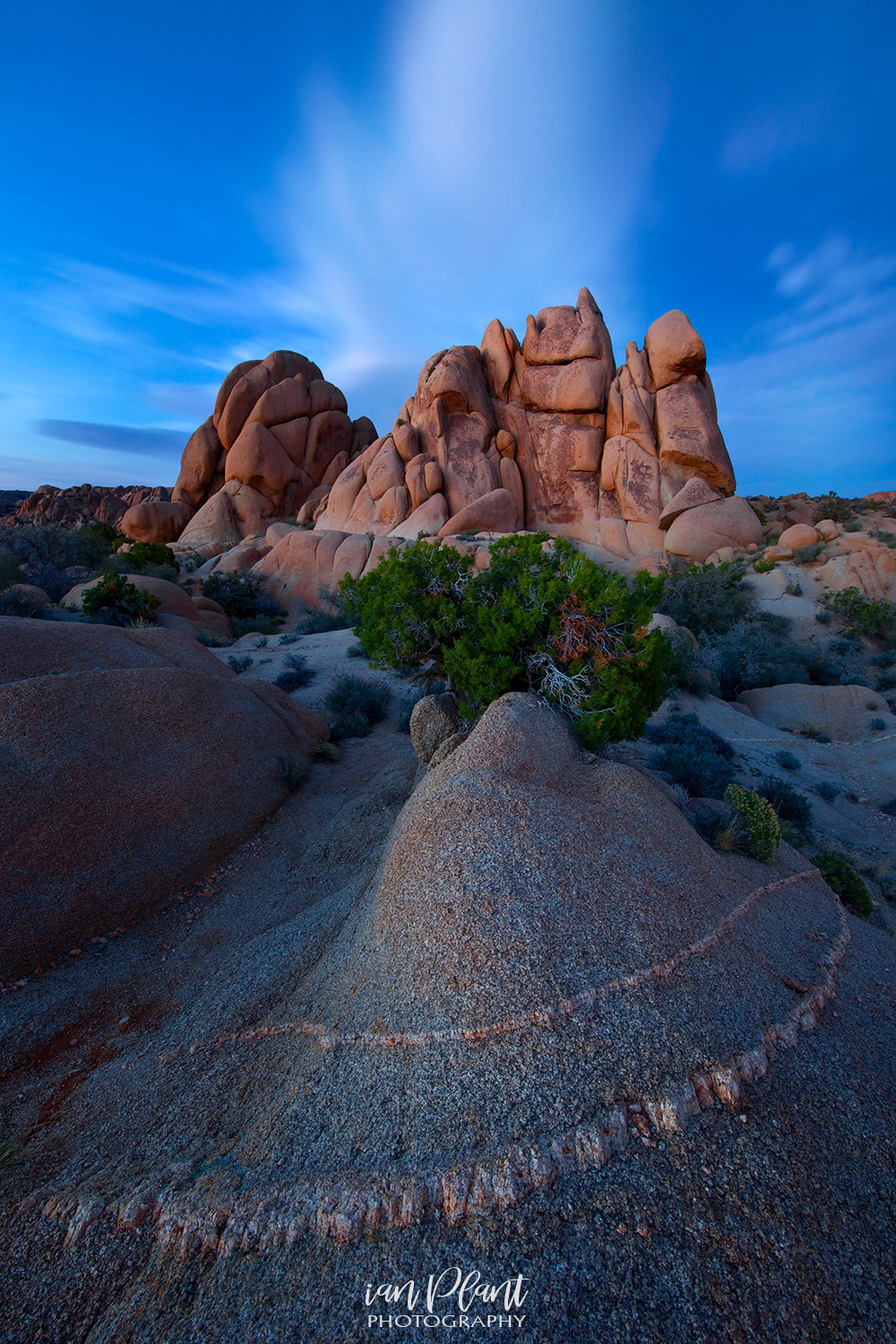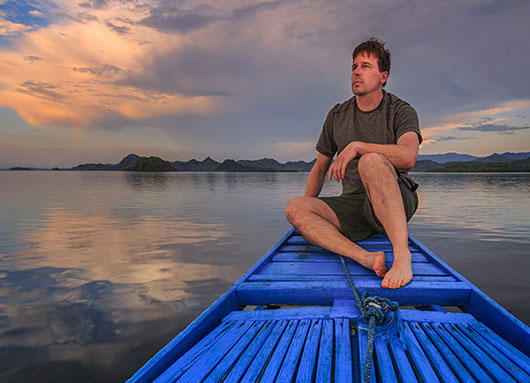In my over ten years as a professional landscape photographer, I’ve learned that artistic composition—the positioning of visual elements within the picture frame—is vitally important to taking successful photos. A critical component of mastering composition is learning how to recognize and creatively use abstract shapes. When assessing potential landscape subjects, I always keep an eye out for objects that form a triangle shape, as I’ve found that you can make powerful compositions by using triangles in landscape photography.
 I used the triangle-shaped boulder in the water to lead the viewer’s eye deeper into the composition. Great Smoky Mountains National Park, USA. Canon 5DII, Nikon 14-24mm f/2.8 lens with Canon adapter, polarizer filter, ISO 100, f/11, 1 second.
I used the triangle-shaped boulder in the water to lead the viewer’s eye deeper into the composition. Great Smoky Mountains National Park, USA. Canon 5DII, Nikon 14-24mm f/2.8 lens with Canon adapter, polarizer filter, ISO 100, f/11, 1 second.
What is a triangle?
Okay, so I’m pretty sure you already know that a triangle is a closed figure with three lines and three angles. Many objects in the natural world approximate the triangle shape, including mountains, conifer trees, and some rocks and leaves. Of course, most natural objects don’t perfectly form a triangle, but if you use your imagination a bit, you’ll start to notice a lot of objects that look more or less like triangles.
 The boulder at the bottom of the picture frame isn’t a perfect triangle, but that’s okay—it easily approximates a general triangle shape (some of the mountains in the background also have triangle shapes). Zion National Park, USA. Canon 5DII, Nikon 14-24mm f/2.8 lens with Canon adapter, ISO 100, f/11, 2 seconds.
The boulder at the bottom of the picture frame isn’t a perfect triangle, but that’s okay—it easily approximates a general triangle shape (some of the mountains in the background also have triangle shapes). Zion National Park, USA. Canon 5DII, Nikon 14-24mm f/2.8 lens with Canon adapter, ISO 100, f/11, 2 seconds.
Abstract triangles are formed by the interaction of three objects
You shouldn’t just be looking for obviously triangle-shaped objects; you should also be looking for “implied” or “abstract” triangles, which are formed by the interaction of three significant objects. The image below is a good example of three objects interacting to form an abstract triangle. If you draw a line between the two boulders in the stream, and then draw a line connecting each boulder to the bright wedge of the sandstone canyon wall in the background, a triangle shape is formed. So, an implied triangle shape can emerge from your choice of objects you include within a composition; furthermore, the shape of the triangle can be varied depending on your position relative to each object. A lot of landscape photographers use this as a general strategy when scouting for potential compositions, looking for three prominent objects in close enough proximity to one another to form an implied triangle.
 The three most prominent visual elements in this scene, when connected by lines, form a triangle. I was able to alter the skew of the triangle by changing my camera position. Zion National Park, USA. Canon 5DII, Nikon 14-24mm f/2.8 lens with Canon adapter, polarizer filter, ISO 200, f/14, 4 seconds.
The three most prominent visual elements in this scene, when connected by lines, form a triangle. I was able to alter the skew of the triangle by changing my camera position. Zion National Park, USA. Canon 5DII, Nikon 14-24mm f/2.8 lens with Canon adapter, polarizer filter, ISO 200, f/14, 4 seconds.
How is a triangle used in landscape photography?
Triangles can be used many ways in landscape photography compositions. Triangles can help create compositional stability, providing the visual design with balance and symmetry. Also, a triangle can simplify a composition, organizing the visual design around a basic shape that viewers automatically recognize and understand. Arguably, symmetrically-shaped triangles create balance and harmony in a landscape composition, while asymmetrically skewed triangles are more dynamic and energetic.
 I framed the reflection of this iconic peak within a rainwater pool with a triangular shape. The triangle gives the composition balance and symmetry. Devils Tower National Monument, USA. Canon 5DSR, Canon 16-35mm f/2.8 lens, ISO 100, f/8, 1/15 second.
I framed the reflection of this iconic peak within a rainwater pool with a triangular shape. The triangle gives the composition balance and symmetry. Devils Tower National Monument, USA. Canon 5DSR, Canon 16-35mm f/2.8 lens, ISO 100, f/8, 1/15 second.
But triangles can also be used in landscape photography to lead or point the viewer’s eye, encouraging the viewer to more fully explore the composition. This is because triangles naturally form what is called a “vanishing point”—which is a useful technique for creating compelling visual designs.
The triangle and vanishing point
The concept of vanishing point in art is a product of the Renaissance, and it is pretty simple: a vanishing point is nothing more than the point in the distance at which objects become too small to see. Think, for a moment, about a set of railroad tracks. Even though the tracks are parallel, when you look down a set of tracks, they seem to steadily converge to a point at the horizon. This point of convergence is the vanishing point. Easy, right?
Vanishing point revolutionized perspective in painting during the Renaissance, and it allowed painters to create depth and a realism of perspective that had not been seen before in art. It didn’t take artists long, however, to figure out that vanishing also riveted the viewer’s eye, compelling it to travel headlong deeper into the composition.
 The shadow lines all converge and create a vanishing point near the top of the composition. If you mentally close the lines off at the bottom, a triangle shape is formed. Namib-Naukluft National Park, Namibia. Canon 5DIII, Canon 16-35mm f/2.8 lens, ISO 100, f/13, 1/160 second.
The shadow lines all converge and create a vanishing point near the top of the composition. If you mentally close the lines off at the bottom, a triangle shape is formed. Namib-Naukluft National Park, Namibia. Canon 5DIII, Canon 16-35mm f/2.8 lens, ISO 100, f/13, 1/160 second.
Part of what makes triangle shapes so interesting and useful to landscape photographers is that they naturally create a vanishing point. Actually, you might have already noticed that a triangle creates three vanishing points, one for each angle of the triangle where two lines converge. But when you use a triangle shape in your landscape composition, the top part of the triangle is most likely to be the part that the viewer focuses on most; if the triangle has one pointy end at the top, it creates a compelling vanishing point that pulls the viewer’s eye from the bottom to the top of the composition.
 The boulder at the bottom of the photo forms a triangle, with one pointy end facing up. This forms a vanishing point, leading the viewer’s eye from the bottom to the top of the composition. Joshua Tree National Park, USA. Canon 5DII, Nikon 14-24mm f/2.8 lens with Canon adapter, ISO 400, f/14, 30 seconds.
The boulder at the bottom of the photo forms a triangle, with one pointy end facing up. This forms a vanishing point, leading the viewer’s eye from the bottom to the top of the composition. Joshua Tree National Park, USA. Canon 5DII, Nikon 14-24mm f/2.8 lens with Canon adapter, ISO 400, f/14, 30 seconds.
I often use triangles at the bottom of my landscape photos with one end pointing up to create a sense of depth and to lead the viewer’s eye into the scene. I find that diagonal lines radiating from the lower corners into the center of the composition—forming an implied triangle—can very powerfully draw the viewer into the composition.
 The ferns at the bottom of the image frame radiate from the corners and edges to diagonally converge, forming a triangle. Olympic National Park, USA. Canon 5DIII, Canon 16-35mm f/2.8 lens, polarizer filter, ISO 400, f/16, 0.8 seconds.
The ferns at the bottom of the image frame radiate from the corners and edges to diagonally converge, forming a triangle. Olympic National Park, USA. Canon 5DIII, Canon 16-35mm f/2.8 lens, polarizer filter, ISO 400, f/16, 0.8 seconds.
Conclusion
Triangles have many uses in landscape photography. They can powerfully compel the viewer’s eye, pointing to other important parts of the composition. So, always be on the lookout for natural objects that form a triangle shape. Or, you can create a triangle by visually connecting three prominent objects. If you want to learn more about visual design, check out my ebook/video combo Visual Flow: Mastering the Art of Composition.

About the author: Whether hanging over the rim of an active volcano, braving the elements to photograph critically-endangered species, or trekking deep into the wilderness to places most people will never see, world-renowned professional photographer Ian Plant travels the globe seeking out amazing places and subjects in his never-ending quest to capture the beauty of our world with his camera. Ian is a frequent contributor to many leading photo magazines, Managing Editor of Outdoor Photography Guide, a Tamron Image Master, and the author of numerous books and instructional videos. Known for his inspiring images and single-minded dedication to creating the perfect photo, Ian has reached hundreds of thousands of people around the world in his mission to inspire and educate others in the art of photography. You can see more of his work at www.ianplant.com.
Have something to add to the story? Leave a comment or email editor@outdoorphotographyguide.com.

I looked at all the photos and not a one of them makes me think the photographer chose that because there was a triangle in it. I'd bet if I looked through my thousands of photos I'd find plenty of photos with a triangle in it. Just can't imagine manipulating a scene JUST to contrive a triangle??
I would love to reprint this article in my photo club's digital newsletter (www.spsphoto.org). I will give credit to Ian, as well as include links to his website and Outdoor Photography. Please let me know. Many thanks for a detailed and well-written article.
Great article and the images are not only helpful but exquisite.
Well explained...Thanks for sharing
As a painter and emerging photographer I use composition principles all the time This was an excellent article Would like to send you a photo I took in Vietnam that exemplifies your point. Where should i send it ?
Great Stuff!
How do you sign your photographic works? Do you use a specific app?
Ian thanks! I have been struggling to develop strategies for photographic composition because I know it's important, but I was not sure WHAT was important or WHY? I have no background in art history or art appreciation, so this really helps...
Well done, Ian, a good read.
Great read and idea! I'm sure I'll be trying this idea later. Thank you for the information.